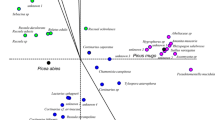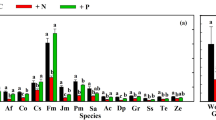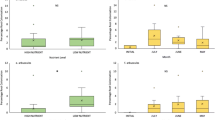Abstract
Mycorrhizal (Lactarius rufus Fr.) and non-mycorrhizal Norway spruce seedlings (Picea abies Karst.) were grown in a sand culture and inoculated with protozoa (naked amoebae and flagellates) extracted from native forest soil or with protozoa grown on agar cultures. A soil suspension from which the protozoa were eliminated by filtration or chloroform fumigation was used as a control. After 19 weeks of growth in a climate chamber at 20–22°C, the seedlings were harvested. Protozoa reduced the number of bacterial colony-forming units extracted from the rhizoplane of both non-mycorrhizal and mycorrhizal seedlings and significantly increased seedling growth. However, concentrations of mineral nutrients in needles were not increased in seedlings with protozoan treatment. It is concluded that the increased growth of seedling was not caused by nutrients released during amoebal grazing on rhizosphere micro-organisms. The protozoa presumably affected plant physiological processes, either directly, via production of phytohormones, or indirectly, via modification of the structure and performance of the rhizosphere microflora and their impact on plant growth. Mycorrhizal colonization significantly increased the abundance of naked amoebae at the rhizoplane. Our observations indicate that protozoa in the rhizosphere interact significantly with mycorrhizae.
Similar content being viewed by others
References
Alphei J, Scheu S (1993) Effects of biocidal treatments on biological and nutritional properties of a mull-structured woodland soil. Geoderma 56:435–448
Azcón-Aguilar C, Barea JM (1992) Interaction between mycorrhizal fungi and other rhizosphere microorganisms. In: Allen MF (ed) Mycorrhizal functioning. Chapman and Hall, London, pp 163–198
Bamforth SS (1988) Interactions between protozoa and other organisms. Agric Ecosyst Environ 24:229–234
Burr FJ, Caesar A (1984) Beneficial plant bacteria. Crit Rev Plant Sci 2:1–20
Chakraborty S, Theodorou C, Bowen GD (1985) The reduction of root colonization by mycorrhizal fungi by mycophagus amoebae. Can J Microbiol 31: 295–297
Clarholm M (1985) Interactions of bacteria, protozoa and plants leading to mineralization of soil nitrogen. Soil Biol Biochem 17:1891–187
Clarholm M (1989) Effects of plant-bacterial-amoebal interactions on plant uptake of nitrogen under field conditions. Biol Fertil Soils 8:373–378
Coleman DC (1985) Through a ped darkly: an ecological assessment of soil-root-microbial-faunal interactions. In: Fitter AH, Atkinson D, Read DJ, Usher MB (eds) Ecological interactions in soil. Blackwell, Oxford, pp. 1–21
Coleman DC, Crossley DAJ, Beare MH, Hendrix PF (1988) Interactions of organisms at root/soil and litter/soil interfaces in terrestrial ecosystems. Agric Ecosyst Environ 24:117–134
Darbyshire JF, Greaves MP (1967) Protozoa and bacteria in the rhizosphere of Sinapis alba L., Trifolium repens L. and Lolium perenne L. Can J Microbiol 13:1057–1068
Devêvre O, Garbaye J, Perrin R (1993) Experimental evidence of a deleterious soil microflora associated with Norway spruce decline in France and Germany. Plant Soil 148:145–153
Driessche P van den, Driessche R van den (1991) Growth analysis. In: Driessche R van den (ed) Mineral nutrition of conifer seedlings. CRC Press, Boca Raton, Fla, pp 61–84
Elliott ET, Coleman DC, Cole CV (1979) The influence of amoebae on the uptake of nitrogen by plants in gnotobiotic soil. In: Harley JL, Russell RS (eds) The soil-root interface. Academic Press, London, pp 221–229
Eltrop L (1993) Role of ectomycorrhizas in the mineral nutrition of Norway spruce seedlings (Picea abies (L) Karst). PhD thesis, Univ Hohenheim, Grauer Verlag, Wendlingen, Germany
Fitter AH, Sanders IR (1992) Interactions with the soil fauna. In: Allen MF (ed) Mycorrhizal functioning. Chapman and Hall, London, pp 333–354
Foster RC, Dormaar JF (1991) Bacterial-grazing amoebae in situ in the rhizosphere. Biol Fertil Soils 11:83–87
Garbaye J (1991) Biological interactions in the mycorrhizosphere. Experientia 47:370–375
Godbold DL, Fritz E, Hüttermann A (1988) Aluminum toxicity and forest decline. Proc Natl Acad Sci USA 85:3888–3892
Griffiths BS (1990) A comparison of microbial-feeding nematodes and protozoa in the rhizosphere of different plants. Biol Fertil Soils 9:83–88
Griffiths B, Robinson D (1992) Root-induced nitrogen mineralisation, a nitrogen balance model. Plant Soil 139:253–263
Harley JL, Smith SE (1983) Mycorrhizal symbiosis. Academic Press, London
Heal OW (1963) Soil fungi as food for amoebae. In: Doeksen J, Drift I van der (eds) Soil organisms. North Holland, Amsterdam, pp 289–297
Hensel M, Bieleit G, Meyer R, Jagnow G (1990) A reliable method for the selection of axenic seedlings. Biol Fertil Soils 9:281–282
Hetrick BAD (1991) Mycorrhizas and root architecture. Experientia 47:355–362
Ingestad T (1982) Relative addition rate and external concentration: driving variables used in plant nutrition research. Plant Cell Environ 5:443–453
Jentschke G (1989) Die Wirkung von Aluminium, Blei un Stickstoff auf mykorrhizierte Fichtenkeimlinge in monoxenischer Sandkultur PhD thesis, Univ Göttingen
Jentschke G, Godbold DL, Hüttermann A (1991) Culture of mycorhizal tree seedlings under controlled conditions: effects of nitrogen and aluminium. Physiol Plant 81:408–416
Kuikman PJ, Veen JA van (1989) The impact of protozoa on the availability of bacterial nitrogen to plants. Biol Fertil Soils 8:13–18
Kuikman PJ, Jansen AG, Veen JA van, Zehnder AJB (1990) Protozoan predation and the turnover of soil organic carbon and nitrogen in the presence of plants. Biol Fertil Soils 10:22–28
Kuikman PJ, Jansen AG, Veen JA van (1991) 15N-nitrogen mineralization from bacteria by protozoan grazing at different soil moisture regimes. Soil Biol Biochem 23:193–200
Laheurte F, Leyval C, Berthelin J (1990) Root exudates of maize, pine and beech seedlings influenced by mycorrhizal and bacterial inoculation. Symbiosis 9:111–116
Leyval C, Berthelin J (1993) Rhizodeposition and net release of soluble organic compounds by pine and beech seedlings inoculated with rhizobacteria and ectomycorrhizal fungi. Biol Fertil Soils 15:259–267
Lynch JM, Whipps JM (1990) Substrate flow in the rhizosphere. Plant Soil 129:1–10
Marschner H (1986) Mineral nutrition of higher plants. Academic Press, London
Marx DH (1969) The influence of ectotrophic mycorrhizal fungi on the resistance of pine roots to pathogenic infections. I. Antagonism of mycorrhizal fungi to root pathogenic fungi and soil bacteria. Phytopathology 59:153–163
Newman EI (1985) The rhizosphere: carbon sources and microbial populations. In: Fitter AH, Atkinson D, Read DJ, Usher MB (eds) Ecological interactions in soil. Blackwell, Oxford, pp 107–121
Nikolyuk VF (1969) Some aspects of the study of soil protozoa. Acta Protozool 7:99–108
Old KM, Patrick ZA (1979) Giant soil amoebae: potential biocontrol agents. In: Schippers B, Gams W (eds) Soil-borne plant pathogens. Academic Press, London, pp 617–628
Page FC (1976) An illustrated key to freshwater and soil amoebae Freshwater Biological Association, Ambleside, Cumbria, Sci Publ 34, pp 11–16
Palmer JG, Hacskaylo E (1970) Ectomycorrhizal fungi in pure culture. I. Growth on single carbon sources. Physiol Plant 23:1187–1197
Paulitz TC, Linderman RG (1991) Mycorrhizal interactions with soil organisms. In: Arora B, Rai DK, Mukerji KG, Knudsen GR (eds) Handbook of applied mycology, vol 1. Marcel Dekker, New York, pp 77–129
Rutherford PM, Juma NG (1992) Influence of soil texture on protozoa-induced mineralization of bacterial carbon and nitrogen. Can J Soil Sci 72:183–200
SAS Institute (1987) SAS/STAT guide for personal computers, version 6. SAS Institute Inc, Cary, NC, pp 549–640
Schlechte G (1986) Zur Mykorrhizapilzflora in geschädigten Forstbeständen. Z Mykol 52:225–232
Singh BN (1946) A method of estimating the number of soil protozoa, especially amoebae, based on their differential feeding on bacteria. Ann Appl Biol 33:112–119
Singh BN (1955) Culturing soil protozoa and estimating their numbers in soil. In: McE Kevan DK (ed) Soil zoology. Butterworth, London, pp 403–411
Tennant D (1975) A test of a modified line intersect method of estimating root length. J Ecol 63:995–1001
Verhagen FJM, Duyts H, Laanbroek HJ (1993) Effects of grazing by flagellates on competition for ammonium between nitrifying and heterotrophic bacteria in soil columns. Appl Environ Microbiol 59:2099–2106
Weekers PHH, Bodelier PLE, Wijen JPH, Vogels GD (1993) Effects of grazing by the free-living soil amoebae Acanthamoeba castellanii, Acanthamoeba polyphaga, and Hartmannella vermiformis on various bacteria. Appl Environ Microbiol 59:2317–2319
Woods LE, Cole CV, Elliott ET, Anderson RV, Coleman DC (1982) Nitrogen transformations in soil as affected by bacterial-microfaunal interactions. Soil Biol Biochem 14:93–98
Author information
Authors and Affiliations
Rights and permissions
About this article
Cite this article
Jentschke, G., Bonkowski, M., Godbold, D.L. et al. Soil protozoa and forest tree growth: non-nutritional effects and interaction with mycorrhizae. Biol Fertil Soils 20, 263–269 (1995). https://doi.org/10.1007/BF00336088
Received:
Issue Date:
DOI: https://doi.org/10.1007/BF00336088




